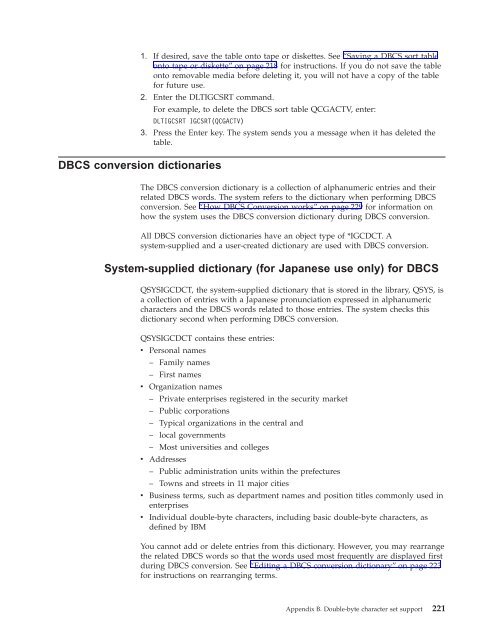Create successful ePaper yourself
Turn your PDF publications into a flip-book with our unique Google optimized e-Paper software.
1. If desired, save the table onto tape or diskettes. See “Saving a DBCS sort table<br />
onto tape or diskette” on page 218 for instructions. If you do not save the table<br />
onto removable media before deleting it, you will not have a copy of the table<br />
for future use.<br />
2. Enter the DLTIGCSRT command.<br />
For example, to delete the DBCS sort table QCGACTV, enter:<br />
DLTIGCSRT IGCSRT(QCGACTV)<br />
3. Press the Enter key. The system sends you a message when it has deleted the<br />
table.<br />
DBCS conversion dictionaries<br />
The DBCS conversion dictionary is a collection of alphanumeric entries and their<br />
related DBCS words. The system refers to the dictionary when performing DBCS<br />
conversion. See “How DBCS Conversion works” on page 229 for information on<br />
how the system uses the DBCS conversion dictionary during DBCS conversion.<br />
All DBCS conversion dictionaries have an object type of *IGCDCT. A<br />
system-supplied and a user-created dictionary are used with DBCS conversion.<br />
System-supplied dictionary (for Japanese use only) for DBCS<br />
QSYSIGCDCT, the system-supplied dictionary that is stored in the library, QSYS, is<br />
a collection of entries with a Japanese pronunciation expressed in alphanumeric<br />
characters and the DBCS words related to those entries. The system checks this<br />
dictionary second when performing DBCS conversion.<br />
QSYSIGCDCT contains these entries:<br />
v Personal names<br />
– Family names<br />
– First names<br />
v Organization names<br />
– Private enterprises registered in the security market<br />
– Public corporations<br />
– Typical organizations in the central and<br />
– local governments<br />
– Most universities and colleges<br />
v Addresses<br />
– Public administration units within the prefectures<br />
– Towns and streets in 11 major cities<br />
v Business terms, such as department names and position titles commonly used in<br />
enterprises<br />
v Individual double-byte characters, including basic double-byte characters, as<br />
defined by <strong>IBM</strong><br />
You cannot add or delete entries from this dictionary. However, you may rearrange<br />
the related DBCS words so that the words used most frequently are displayed first<br />
during DBCS conversion. See “Editing a DBCS conversion dictionary” on page 223<br />
for instructions on rearranging terms.<br />
Appendix B. Double-byte character set support 221
















